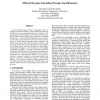Free Online Productivity Tools
i2Speak
i2Symbol
i2OCR
iTex2Img
iWeb2Print
iWeb2Shot
i2Type
iPdf2Split
iPdf2Merge
i2Bopomofo
i2Arabic
i2Style
i2Image
i2PDF
iLatex2Rtf
Sci2ools
ISCA
2002
IEEE
2002
IEEE
Efficient Dynamic Scheduling Through Tag Elimination
An increasingly large portion of scheduler latency is derived from the monolithic content addressable memory (CAM) arrays accessed during instruction wakeup. The performance of the scheduler can be improved by decreasing the number of tag comparisons necessary to schedule instructions. Using detailed simulation-based analyses, we find that most instructions enter the window with at least one of their input operands already available. By putting these instructions into specialized windows with fewer tag comparators, load capacitance on the scheduler critical path can be reduced, with only very small effects on program throughput. For instructions with multiple unavailable operands, we introduce a last-tag speculation mechanism that eliminates all remaining tag comparators except those for the last arriving input operand. By combining these two tag-reduction schemes, we are able to construct dynamic schedulers with approximately one quarter of the tag comparators found in conventional d...
Hardware | Input Operand | Instruction | ISCA 2002 | Tag Comparators |
Related Content
| Added | 15 Jul 2010 |
| Updated | 15 Jul 2010 |
| Type | Conference |
| Year | 2002 |
| Where | ISCA |
| Authors | Dan Ernst, Todd M. Austin |
Comments (0)

